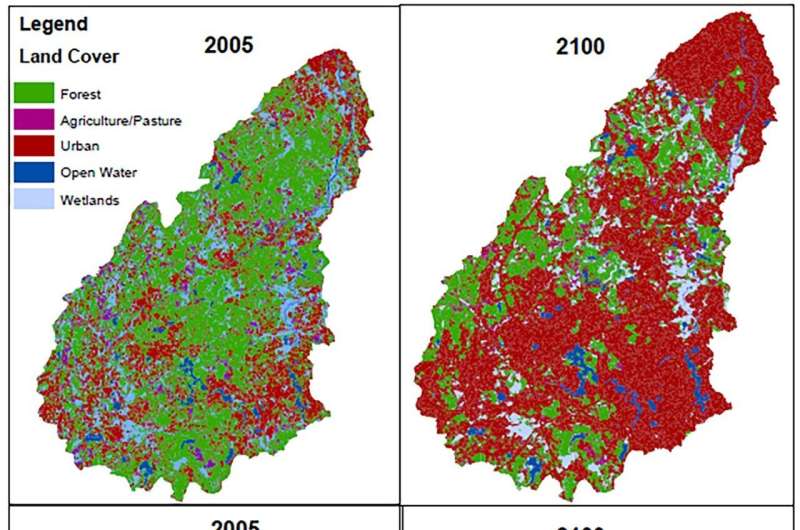This article has been reviewed according to Science X's editorial process and policies. Editors have highlighted the following attributes while ensuring the content's credibility:
fact-checked
peer-reviewed publication
trusted source
proofread
New research links changes in land use to water quality and quantity

Researchers at the University of Massachusetts Amherst recently published a study in the journal PLOS Water that focuses on the Sudbury-Assabet and Concord watershed in eastern Massachusetts, and which links hydrological changes, including floods, drought and runoff, to changing patterns of land use.
"We all live in a watershed" says Timothy Randhir, professor of environmental conservation at UMass Amherst and the paper's senior author. "We're constantly modifying our landscape, turning what were once forests into roads, parking lots and backyards. We're changing the landscape from one that was once hydrologically resilient to one that pushes water downstream."
But it can be hard to see the complex links between changes in land use and changes in the hydrological cycle. For instance, much of Massachusetts is now subject to the paradoxical situation in which summer drought follows spring flooding. Surely if there's enough extra water to flood the streets in towns throughout the state then there should be plenty of groundwater left for drinking, lawn watering and maintaining the levels of streams and lakes?
This is where thinking like a watershed comes in. "Every drop of rain has two pathways when it falls," says Randhir. "It can either run off the land into a stream, or it can infiltrate the soil and slowly trickle down to the water table."
But by paving over large swaths of land, burying swamps and wetlands and channelizing rivers, we have made it far more difficult for rain to infiltrate the soil, increasing the likelihood of drought. At the same time, all that runoff pours into streams and rivers, which in turn grows into a deluge as it thunders downstream, fed by even more runoff as it progresses.
To make the links between land use and hydrological effect visible, and to project these effects into the future, Randhir and his graduate student, first author Ammara Talib, focused on the Sudbury-Assabet and Concord watershed in eastern Massachusetts, an area that incorporates both rural areas and suburbs of Boston.
The pair fed historical data describing the changing land-use into a model which projected the trends for the years 2035, 2065 and 2100. The team then fed the results of the land-use model into a hydological model called the Hydrological Simulation Program-FORTRAN.
What they found was that, by 2100, the total forested area will decrease by 51% and impervious areas (roads and parking lots) will increase 75%. These changes will increase annual stream flow by 3%, while runoff will grow by a whopping 69% annually. All this increased runoff will mean more topsoil and other solids in the water (an increase of 54%), and 12% and 13% increases in phosphorous and nitrogen concentrations, respectively.
But none of this need happen.
"We can plan for the future on the watershed scale," says Randhir, by urban planning that implements best practices for sustainable and site-specific land-use measures. These can include creating rain gardens, using permeable pavement in large parking lots and employing vegetated swales to slow the runoff.
"The watershed is a signature of the health of the landscape," says Randhir. "The quality of life in any particular landscape depends on how the watershed is functioning."
More information: Ammara Talib et al, Long-term effects of land-use change on water resources in urbanizing watersheds, PLOS Water (2023). DOI: 10.1371/journal.pwat.0000083
Journal information: PLOS Water
Provided by University of Massachusetts Amherst





















